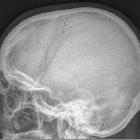Lückenschädel





Lückenschädel skull, also known as lacunar skull or craniolacunae, is a dysplasia of the membranous skull vault and is associated with Chiari II malformations (seen in up to 80% of such cases). The inner table is more affected than the outer, with regions of apparent thinning (corresponding to unossified fibrous bone) of the skull vault. If particularly severe, with the individual lacunae coalescing into larger defects the term craniofenestrae is used.
Pathology
The defect is not one of pressure from within (in contrast to copper beaten skull appearance of hydrocephalus, or normal convolutional markings) but rather of abnormal collagen development and ossification, since the skull vault ossification process is the membranous ossification.
Present at birth and disappear by 5 months.
Associations
Radiographic features
The findings are usually seen on plain skull x-rays or CT.
Lückenschädel skull is characterized by groups of round, oval or finger-shaped pits on the inner surface of the vault (membranous part), separated by ridges of bone. They lie in the thickest part of the frontal, parietal, and upper occipital bones.
Treatment and prognosis
The condition is self-limiting, typically resolving after 6 months of age.
History and etymology
Lückenschädel is a compound German word derived from lücke meaning gap, and schädel meaning skull.
Differential diagnosis
Imaging differential considerations include
Siehe auch:

 Assoziationen und Differentialdiagnosen zu Lückenschädel:
Assoziationen und Differentialdiagnosen zu Lückenschädel:

